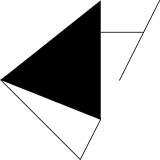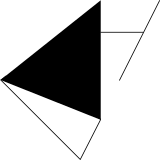While Lucio Fontana used chisels and knives to create real space in his works, transforming his two-dimensional canvases and surfaces into three-dimensional, sculptural objects, Gerhard Richter's painting shows the illusion of space. The oil painting 'Umgeschlagenes Blatt' (1965) deceives the eye: a sheet of paper seems to detach itself from the background and bulge out to the left, making the sketchpad look at first glance almost like a three-dimensional object. Richter's optical illusion is a classic of trompe l'oeil art: two-dimensional depictions of folded paper were already found in antiquity and were used in painting and graphic art. One example from the Von der Heydt Museum's collection is the "Atelierwand" by the Elberfeld artist Johann Richard Seel from 1856, which not only depicts folded papers and book pages on his studio wall, but also works of art such as a boy's head, drawings or paintings next to objects such as a painter's palette.
Richter's "Umgeschlagenes Blatt" is one of a series of fifteen small-format paintings created in 1965/66. The confusion in the series is rooted in Richter's view that art can only ever depict a semblance of reality. With the optical illusion of three-dimensionality in this work, Richter questions the boundaries of art, space and perception. In contrast to this precisely painted illusion of space, Fontana created real space in which the cut and perforation, unlike the brushstroke, cannot be corrected and are therefore not real.
Weitere Medien
- Material & Technik
- Öl auf Leinwand
- Museum
- Museum Kurhaus Kleve – Dauerleihgabe des Freundeskreises Museum Kurhaus und Koekkoek-Haus Kleve e.V., über die Vermittlung von Sonja Mataré, Meerbusch-Büderich, Schenkung von Günter Stockhausen, Krefeld
- Datierung
- 1965
- Inventarnummer
- 1996-XI-II


